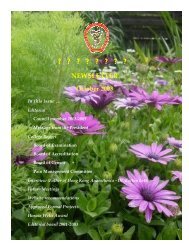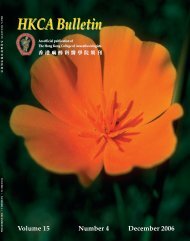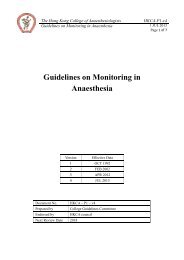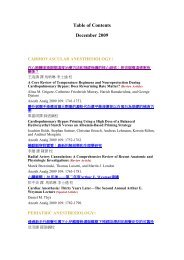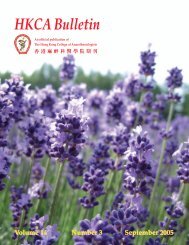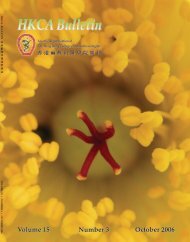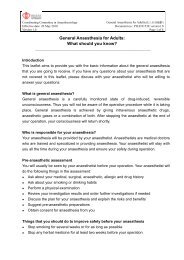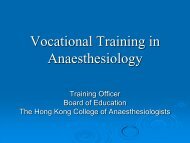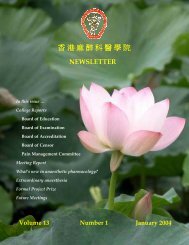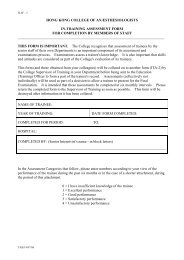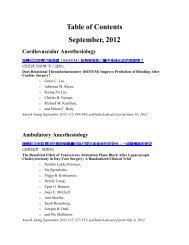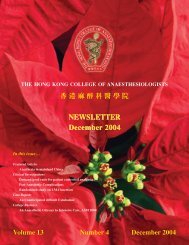July 2005 - The Hong Kong College of Anaesthesiologists
July 2005 - The Hong Kong College of Anaesthesiologists
July 2005 - The Hong Kong College of Anaesthesiologists
Create successful ePaper yourself
Turn your PDF publications into a flip-book with our unique Google optimized e-Paper software.
Bull HK Coll Anaesthesiol Volume 14, Number 2 <strong>July</strong>, <strong>2005</strong><strong>The</strong> aim <strong>of</strong> this study is to evaluate therelative effectiveness <strong>of</strong> forced air warming inpreventing intraoperative hypothermia, whenapplied to the upper or lower body in patientsundergoing prolonged open abdominal surgery.Materials and MethodsA prospective, randomized, single‐blindedstudy was conducted to compare the relativeeffectiveness <strong>of</strong> upper and lower body forced airwarming in patients undergoing prolongedopen abdominal surgery <strong>of</strong> more than 2 hoursduration.Power analysis was based on a type I error<strong>of</strong> 0.05 and a type II error <strong>of</strong> 0.2 using the Powerand Precision computer s<strong>of</strong>tware (Biostat, Inc.,Englewood, NJ, USA). According to the results<strong>of</strong> previous studies 13,14 , we calculated that atleast 42 patients per group is required todemonstrate a mean difference in core bodytemperature <strong>of</strong> 0.5 o C with a standard deviation<strong>of</strong> 0.8 o C.Approval by the hospital ethics committee<strong>of</strong> the study was obtained. Eighty seven adultpatients, older than 18 years, American Society<strong>of</strong> Anesthesiologists physical status I to III,undergoing open abdominal surgery with anexpected duration <strong>of</strong> more than 2 hours, wererecruited in this study. Simple randomisation <strong>of</strong>patients into two groups <strong>of</strong> either the upper orlower body warming was performed. Exclusioncriteria included pre‐existing hypothermia (coretemperature < 36 o C) or hyperthermia (> 38 o C),patients undergoing abdominal aortic surgery,burn injury or multiple traumatic injuries, andsurgery in lithotomy position.Preoperatively, demographic data wererecorded and tympanic membrane temperatures<strong>of</strong> patients were recorded by infrared probe(<strong>The</strong>rmoScan Pro 1, Braun AG, Germany).All patients received general anaesthesiawith tracheal intubation. Nasopharyngeal andrectal thermistor temperature probes (Datexmodel 16561, Helsinki, Finland) were insertedafter induction <strong>of</strong> anesthesia. <strong>The</strong>nasopharyngeal and rectal temperatures <strong>of</strong>patients were continuously monitored duringsurgery using the temperature‐monitoringmodule (model M‐ESTPR 00‐02) and displayedon a Datex AS/3 anesthesia monitor. <strong>The</strong> initialreadings and further readings at 15‐minuteintervals were recorded after induction <strong>of</strong>anesthesia until the end <strong>of</strong> surgery.After baseline recordings, forced airwarming using Warm Touch model 501‐5800(Mallinckrodt Medical, St Louis, MO, USA) wasapplied to all patients for the wholeintraoperative period. For the upper body group,an “upper body blanket” (Warm Touch model503‐0820) was applied to cover the upper trunkand limbs. For the lower body group, a “lowerbody blanket” (Warm Touch model 503‐0830)was applied to cover the lower limbs up to themiddle <strong>of</strong> the thighs. <strong>The</strong> forced air warmerswere initially set to the “high” setting for bothgroups. <strong>The</strong> warmer settings were reduced tomedium or low if the core temperature exceeded37.5 o C.All intravenous and irrigation fluids usedwere warmed in fluid warming cabinet prior touse. Circle anesthetic circuits with soda‐limeabsorbers were used. <strong>The</strong> use <strong>of</strong> additionalwarming devices such as heat and moistureexchangers, intravenous fluid warming coils orcirculating water mattresses were recorded. <strong>The</strong>ambient temperature in the operating theatrewas set to 21 o C, and the temperature at the startand end <strong>of</strong> the surgery was recorded using anordinary alcohol thermometer.Statistical analysis <strong>of</strong> temperature readingswas performed using two‐tailed factorialanalysis <strong>of</strong> variance with repeated measures.Analysis <strong>of</strong> demographic data was performedwith χ 2 test for categorical variables andStudent’s t‐test for continuous variables.Results<strong>The</strong> 87 patients enrolled in the study wererandomized into 45 patients in the upper bodygroup and 42 patients in the lower body group.<strong>The</strong> summary <strong>of</strong> patient characteristics is shownin Table 1. No difference was found betweenthe groups in demographic characteristics,preoperative temperature, type <strong>of</strong> surgery,ambient operating theatre temperature and72



